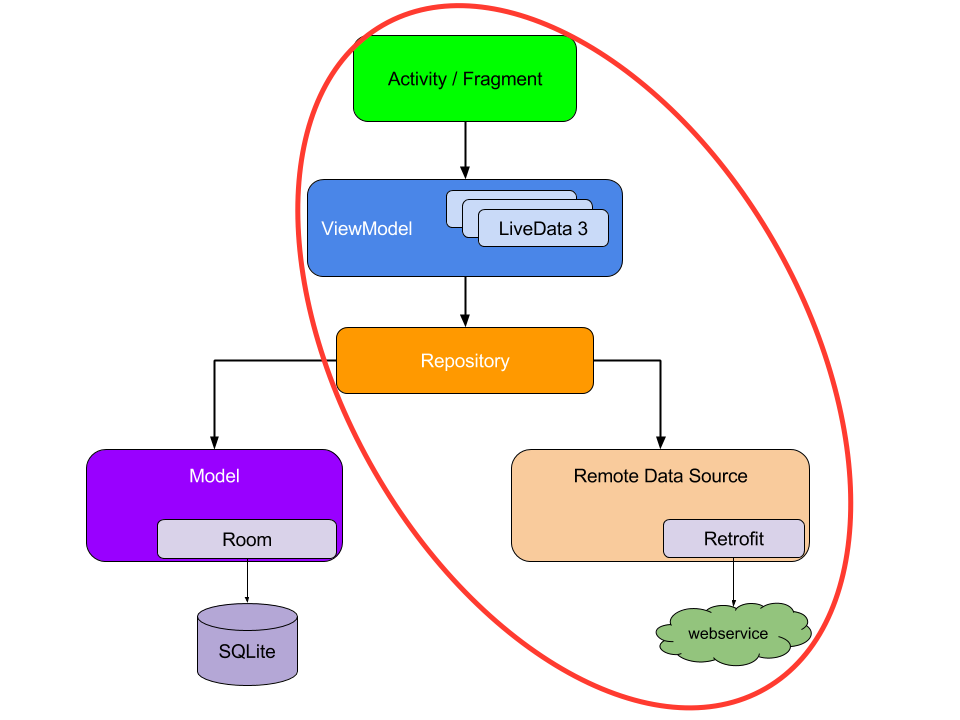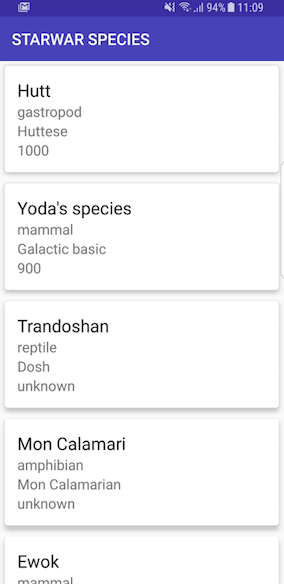Introduction
Android Architecture Component has been one of the topics that really catches my interest (I guess not only me but also, other Android developers). Right now, there are a lot of coding architectures out there such as MVP, MVVM and etc. However, this time Google has provided the official guideline that helps you architect an Android application. Therefore, it really is worth trying it out. In this article, I will focus on calling web service with this architecture.
The source code of this project is on my Github.
Before starting
This article will focus on calling web service with Android Architecture Component. The basics of Kotlin and other libraries such as Dagger, Retrofit will not be included in this article.
How does the architecture look like?

The picture above is taken from the official Android site. I would like to classify the above picture into two layers.
Data Layer
- Repository: Talking to the local data source(database) and remote data source(web service)
- Remote data source: Connecting to web service
Presentation Layer
- ViewModel: Communicating to Repository then update the data to UI (fragment/activity) respectively
- Fragment/Activity: All about the UI (set up and update)
Demo Application
The demo application fetches the data from https://swapi.co. The application will display a list of species in Star War.

In this article, I will also cover common actions dealing with web service including getting the result, handling error, and showing loading UI. You could clone the code from here and look at it along with this article.
Data Layer
Remote data source
Retrofit is used as a remote data source to connect to web service. The below code is the interface for the API. If you use Retrofit, you should already be familiar with this.
Source code package: boonya.ben.callingwebservice.api
interface Swapi {
@GET("species/")
fun getSpecies(): Call<SpeciesList>
}
It only includes one endpoint for the sake of simplicity.
Repository
The calling to web service happens here, and it also includes receiving data and error from web service. Let’s take a look at the code below.
Source code package: boonya.ben.callingwebservice.species
class SpeciesRepositoryImpl(val apiService: Swapi) : SpeciesRepository {
override fun getSpecies(successHandler: (List<Species>?) -> Unit, failureHandler: (Throwable?) -> Unit) {
apiService.getSpecies().enqueue(object : Callback<SpeciesList> {
override fun onResponse(call: Call<SpeciesList>?, response: Response<SpeciesList>?) {
response?.body()?.let {
successHandler(it.speciesList)
}
}
override fun onFailure(call: Call<SpeciesList>?, t: Throwable?) {
failureHandler(t)
}
})
}
}
As you can see that the function getSpecies is higher-order function
A higher-order function is a function that takes functions as parameters or returns a function.
The getSpecies take two functions as arguments
- (successHandler: (List<Species>?) -> Unit ) This function is called when the call to the web service is successful. It takes List<Species> which is the response data from web service as an argument. You will see later how ViewModelcan access this data
- (failureHandler: (Throwable?) -> Unit) This function is invoked when the call to web service is failing. It also takes Throwable as an argument that will be manipulated in ViewModel.
By having Repository, the presentation layer (Activity/Fragment, ViewModel) will not have to directly access to remote sources. Therefore, if we want to use other remote sources instead of Retrofit, we could do without changing the code in the presentation layer.
Presentation Layer
Before going any further, let me introduce you to another new component called LiveData.
Here are some short explanations.
LiveData makes normal model class observable.
MutableLiveData is implementation of LiveData. MutableLiveData can use a method called setValue that can be used to assign the new value to the LiveData.
ViewModel
MutableLiveData is implementation of LiveData. MutableLiveData can use a method called setValue that can be used to assign the new value to the LiveData.
ViewModel
ViewModel is a new component introduced in Android Architecture Component. Instead of putting everything in Activity/Fragment, we could separate the code that is not related to UI into ViewModel. Moreover, ViewModel survive when configuration changes(rotate screen) occur. Normally, Activity/Fragment and everything inside will be recreated if there is configuration change. However, by using ViewModel, the existed one can be reused without creating a new one.
Let’s take a look at an example.
Source code package: boonya.ben.callingwebservice.species
class SpeciesListViewModel : ViewModel() {
@Inject
lateinit var repository: SpeciesRepository
var isLoading = MutableLiveData<Boolean>()
var apiError = MutableLiveData<Throwable>()
var speciesResponse = MutableLiveData<List<Species>>()
fun getSpecies() {
isLoading.value = true
repository.getSpecies(
{
speciesResponse.value = it
isLoading.value = false
},
{
apiError.value = it
isLoading.value = false
})
}
//ignore other code
}
There are three MutableLiveData set up to be observed from activity/fragment.
- isLoading: set to true when start calling web service, and change to false when the call is successful or failure.
- apiError: if there is an error in calling web service the Throwable data will be set to this variable.
- speciesResponse: when the data is successfully obtained from web service, the response data will be set to this variable.
Calling to Repository from ViewModel
To make Repository calls web service, we should trigger the method called getSpecies. This method will call another method in the Repository which I wrote about in the Repository section.
As you can see that repository.getSpecies(…. , ….) takes two functions as arguments. The explanations of each argument are down below.
- The first argument is the function that will be triggered when calling the web service is successful. There will be response data returning from web service can be referred to them as it
- The second argument function is triggered when calling to the web service is fail and the Throwable data can be referred to as it.
Activity
The activity will only contain the code which is related to UI. Here is the code for Activity.
class SpeciesActivity : AppCompatActivity() {
private val registry = LifecycleRegistry(this)
private lateinit var viewModel: SpeciesListViewModel
private lateinit var adapter: SpeciesListAdapter
override fun getLifecycle(): LifecycleRegistry = registry
override fun onCreate(savedInstanceState: Bundle?) {
super.onCreate(savedInstanceState)
setContentView(R.layout.activity_species)
//set up ui
viewModel = createViewModel()
attachObserver()
viewModel.getSpecies()
}
private fun attachObserver() {
viewModel.isLoading.observe(this, Observer<Boolean> {
it?.let { showLoadingDialog(it) }
})
viewModel.apiError.observe(this, Observer<Throwable> {
it?.let { Snackbar.make(rvSpecies, it.localizedMessage, Snackbar.LENGTH_LONG).show() }
})
viewModel.speciesResponse.observe(this, Observer<List<Species>> {
it?.let { adapter.notifyDataSetChanged() }
})
}
private fun createViewModel(): SpeciesListViewModel =
ViewModelProviders.of(this).get(SpeciesListViewModel::class.java).also {
ComponentInjector.component.inject(it)
}
private fun showLoadingDialog(show: Boolean) {
if (show) progressBar.visibility = View.VISIBLE else progressBar.visibility = View.GONE
}
}
To make the activity work with Android Architecture Component, the activity should implement LifecycleRegistryOwner and also override the method getLifeCycle() like above.
Let’s take a close look at attachObserver() method. This activity will observe three MutableLiveData in ViewModel.
- viewModel.isLoading: when change occurs to this variable showLoadingDialog method will be triggered to show or hide progressBar
- viewModel.apiError: Snackbar with an error message will show if the change occurs to this variable.
- viewModel.speciesResponse: The recycler adapter will be notified when data is set to this value
Conclusion
I personally like Android Architecture Component a lot. Not only it allows you to write more testable and more maintainable code but also solve the pain that most of Android developer faces like handling configuration change. If you are about to start a new project, it really worth check this architecture out.
Reference
- https://blacklenspub.com/พอกันทีกับ-god-activity-มาวางโครงดีๆ-ด้วย-architecture-components-d89302734ab8